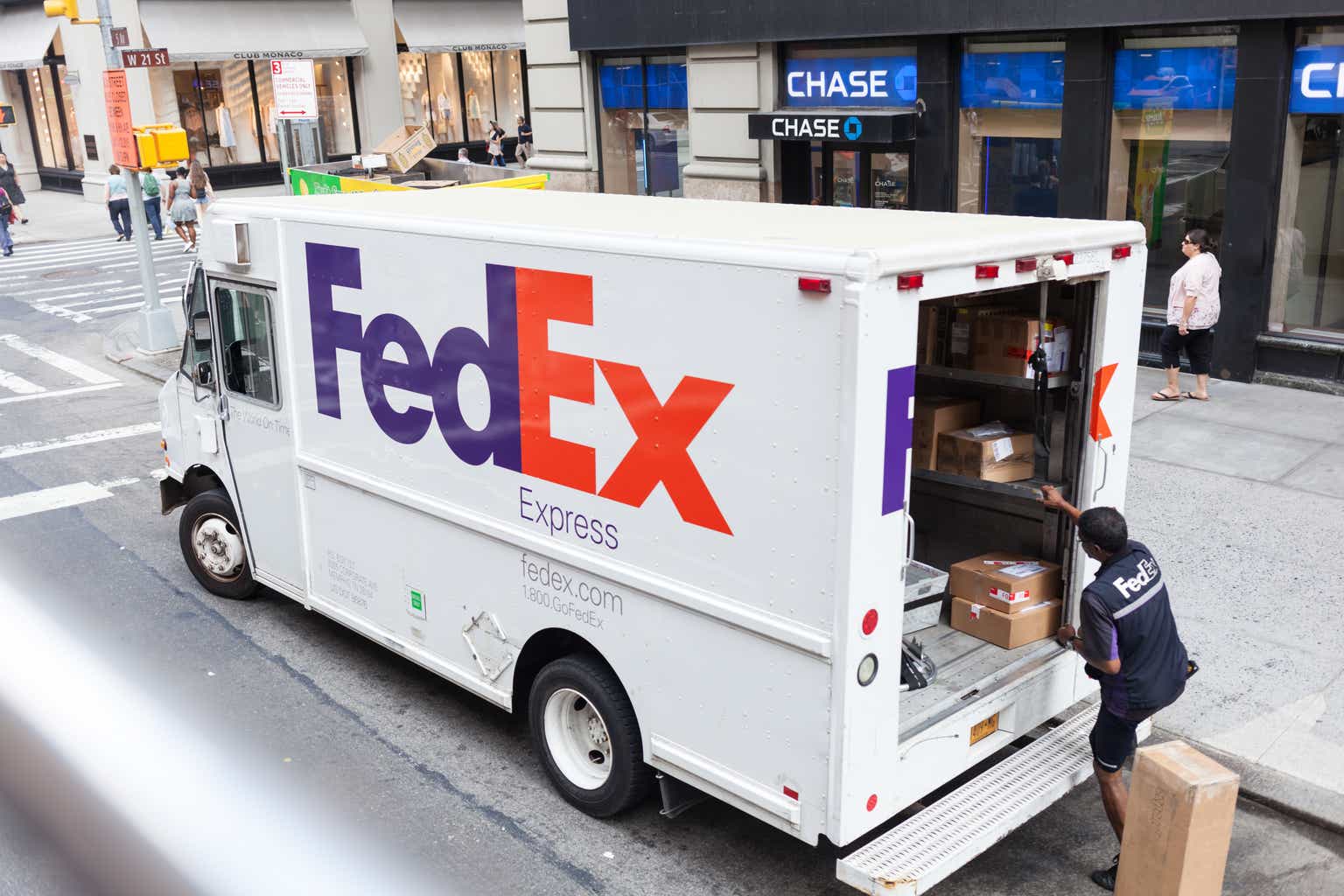FedEx (NYSE:FDX) reported their fiscal Q1 ’24 after the bell on Wednesday, September 20th, 2023, and the stock jumped after hours and finished 11% higher the next trading day.
While revenue missed slightly coming in at $21.68 billion, declining 7% year-over-year, (y.y.) EPS saw a 22% “upside surprise” beating consensus estimates of $3.72, printing $4.55 per share.
The driver of the EPS upside was the improvement in Ground operating margin of 480 bp’s or nearly 5% to 13% when a closer-to-10% operating margin was expected.
FedEx Express is still an issue, with the operating margin coming in at roughly 2%, vs a higher Street consensus expectation.
FedEx’s greatest problem right now and over the last 5 – 10 years, is Express and while it doesn’t seem to be a stated objective in the FedEx “OneDrive” reorganization, my guess is that over time, Raj Subramaniam is going to have to take costs / expenses out of Express and improve that margin, while Ground carries the water (so to speak) and FedEx Freight, which was improving in the post-Covid freight world, continues to contribute positively to FedEx corporate.
As a percentage of FedEx overall, here was each segment’s contribution on a TTM basis:
| Division | % revenue | % op pft |
| Express | 47% | 19% |
| Ground | 38% | 55% |
| Freight | 10% | 26% |
Source: Jeffries
As readers can see, and it’s a point I’ve made in past articles on FedEx, the inability for FedEx to “leverage” Express’s revenue and generate higher operating profit is hindering FDX’s overall earnings and cash-flow capability, and thus hindering FDX’s overall return on their asset base.
FedEx Ground has only been in existence since the year 2000, and yet FedEx has achieved great success with the division and really helped consolidated results by being able to leverage Ground profitability.
Volume will improve in fiscal ’24:
| Division | Q1 ’24 | Q4 ’23 | Q3 ’23 |
| Express | -2% | -7% | -8% |
| Ground | +0.6% | -6% | -11% |
| Freight | -18% (tonnage) | -24% | -19% |
Source: FedEx earnings report, Morningstar research
* Year-over-year change in segment volume
One of the reasons I like Morningstar research is because within their “intrinsic value” estimates for each stock, Morningstar will provide medium and longer-term estimates for revenue growth, volume estimates (for FedEx) and margin estimates which is helpful in gauging where a particular company is at in the recovery cycle.
The sharp decline in ecommerce volume after the pandemic boom starting in mid-2020 and continuing through 2021 resulted in logistical problems for FedEx including labor issues and margin issues and now FedEx is coming out of that sharp slowdown and returning to a more normal operating environment, all of which was discussed in the latest FedEx earnings preview.
Personally, I didn’t put a whole lot of weight on the UPS strike and the Yellow Freight bankruptcy since they were one-time events and what’s more important to valuation is what FedEx looks like as ecommerce volume materializes or “normalizes” and what the FedEx Express cost structure looks like as FedEx corporate right-sizes the division.
Morningstar is assuming just a 1% volume increase for both Express and Ground in fiscal 2024 (three quarters remaining) and over the longer run, assumes a 4% – 5% revenue growth rate for FedEx consolidated, but if readers are looking for one key metric to watch, watch that Express operating margin: if Raj Subramaniam gets the OneDrive cost consolidation or expense rationalization right, the Express operating margin should be the metric that improves the most.
Here’s a brief history of Express’s operating margin:
| Period | Express op mgn |
| 4-qtr avg | 2.85% |
| 12-qtr avg | 5.41% |
| 20-qtr avg | 5.25% |
| 40-qtr avg | 6.27% |
Source: FedEx earnings reports and Stat book
For the segment that generates nearly half of FDX’s revenue, that margin deterioration has to be fixed.
Granted, Covid and the pandemic resulted in major logistical problems for a company like FedEx, but with the world normalizing, FedEx now has an opportunity to fix this issue.
Valuation update:
| Valuation metric | $260 stk price |
| 3-yr avg “expected” Rev gro | 18% |
| 3-yr avg “expected” EPS gro | 3% |
| 3-yr “avg” PE | 12x |
| Price-to-revenue | 0.72 |
| Price-to-book | 2.41x |
| Price-to tang book | 3.18x |
| Price-to-cash-flow | 7x |
| Price-to-free-cash-flow | 20x |
| Free-cash-flow yield | 5% |
| Morningstar new fair value est | $231 |
Source: valuation spreadsheet
The internal valuation spreadsheet puts a “fair value” on FedEx at a little over $300 per share, which is the price it traded at during the pandemic’s work-from-home frenzy in late 2020, early 2021.
Technically, there should be good support for the stock between $225 – $230 and the plan would be to add more stock at those levels, but additional upside could be fairly robust if the Express operating margin improves to anywhere close to historical levels.
Summary/conclusion:
Additional upside for FDX stock is really predicated on how successful “OneDrive” is in taking costs out of the FedEx network and P/L, and really how far Raj Subramaniam can be in transforming FedEx into a “leaner, meaner” trans-global freight company.
Remember, Fred Smith as the Federal Express’s founder just ascended to the Executive Chairman role at Federal Express, so the timing of this now expense and cost “rationalization” is not coincidental in my view.
FedEx Express is or was Fred Smith’s baby – it’s what he founded the company on after coming back from the Vietnam War as a chopper pilot and attending Yale and writing one of his papers on his idea of starting an overnight delivery company (think about that for a minute and what Fred Smith accomplished with his life) but Raj’s responsibility is to now take the company into the 21st century without its founder, and it’s CFO (Alan Graf) and reinvent FedEx heading into what the world will be like in the next 20 – 30 years.
The key metric (in my opinion) for the next 7 quarters to meticulously track for the stock is that Express operating margin, and to see if – even if Express volume rises just 1% in fiscal ’24 – that Express margin can increase as costs are taken out of the Express network. If Express volume does come in higher than 1% in fiscal ’24 and the Express margin does not expand, that tells us something, too.
In my opinion, that’s where the rubber will meet the road for Federal Express stock.
Read the full article here












Leave a Reply